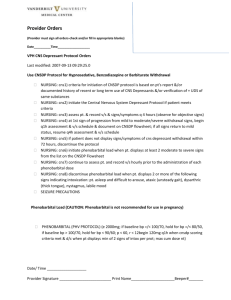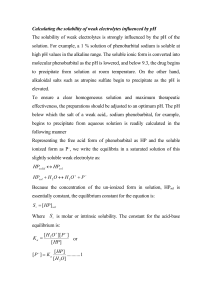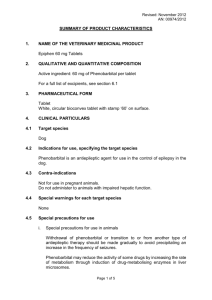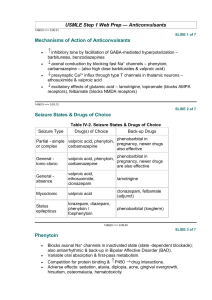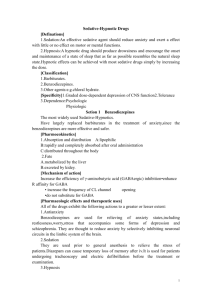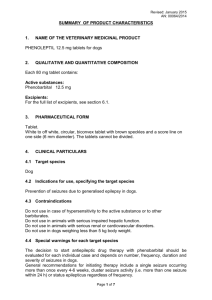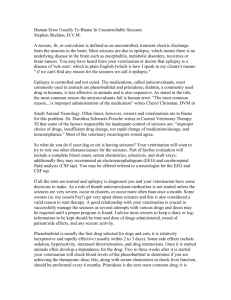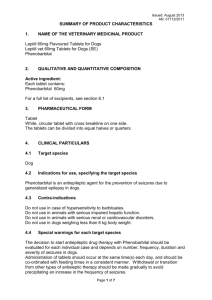Side effects of phenobarbital in epilepsy: a systematic review
advertisement
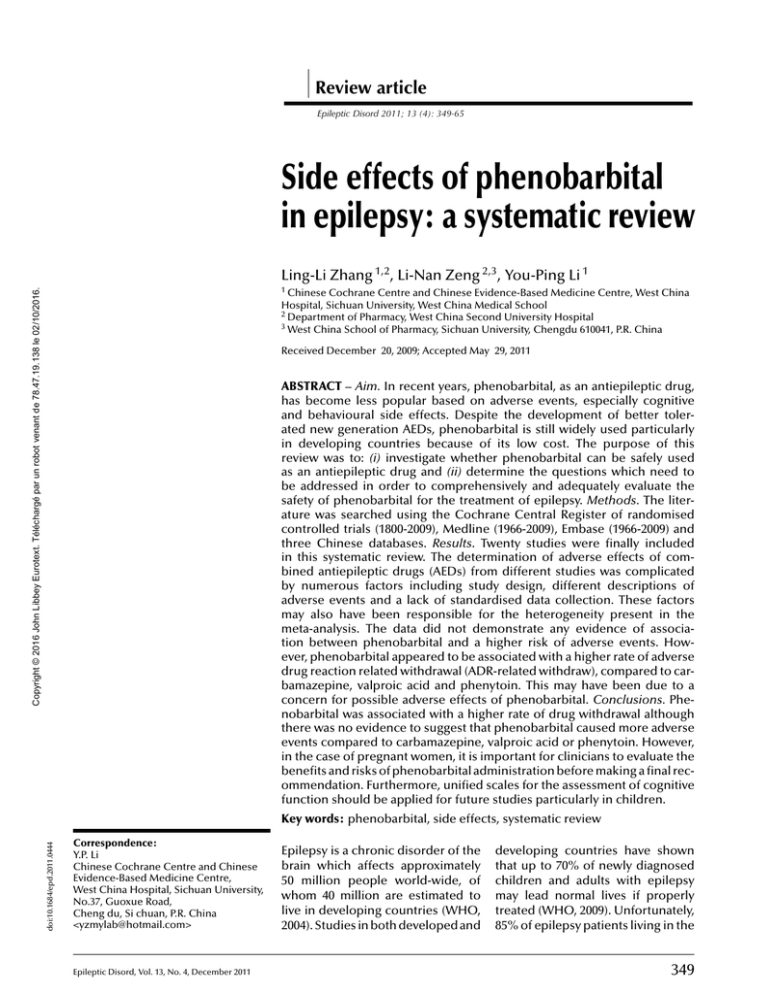
Review article Epileptic Disord 2011; 13 (4): 349-65 Side effects of phenobarbital in epilepsy: a systematic review Ling-Li Zhang 1,2 , Li-Nan Zeng 2,3 , You-Ping Li 1 Copyright © 2016 John Libbey Eurotext. Téléchargé par un robot venant de 78.47.19.138 le 02/10/2016. 1 Chinese Cochrane Centre and Chinese Evidence-Based Medicine Centre, West China Hospital, Sichuan University, West China Medical School 2 Department of Pharmacy, West China Second University Hospital 3 West China School of Pharmacy, Sichuan University, Chengdu 610041, P.R. China Received December 20, 2009; Accepted May 29, 2011 ABSTRACT – Aim. In recent years, phenobarbital, as an antiepileptic drug, has become less popular based on adverse events, especially cognitive and behavioural side effects. Despite the development of better tolerated new generation AEDs, phenobarbital is still widely used particularly in developing countries because of its low cost. The purpose of this review was to: (i) investigate whether phenobarbital can be safely used as an antiepileptic drug and (ii) determine the questions which need to be addressed in order to comprehensively and adequately evaluate the safety of phenobarbital for the treatment of epilepsy. Methods. The literature was searched using the Cochrane Central Register of randomised controlled trials (1800-2009), Medline (1966-2009), Embase (1966-2009) and three Chinese databases. Results. Twenty studies were finally included in this systematic review. The determination of adverse effects of combined antiepileptic drugs (AEDs) from different studies was complicated by numerous factors including study design, different descriptions of adverse events and a lack of standardised data collection. These factors may also have been responsible for the heterogeneity present in the meta-analysis. The data did not demonstrate any evidence of association between phenobarbital and a higher risk of adverse events. However, phenobarbital appeared to be associated with a higher rate of adverse drug reaction related withdrawal (ADR-related withdraw), compared to carbamazepine, valproic acid and phenytoin. This may have been due to a concern for possible adverse effects of phenobarbital. Conclusions. Phenobarbital was associated with a higher rate of drug withdrawal although there was no evidence to suggest that phenobarbital caused more adverse events compared to carbamazepine, valproic acid or phenytoin. However, in the case of pregnant women, it is important for clinicians to evaluate the benefits and risks of phenobarbital administration before making a final recommendation. Furthermore, unified scales for the assessment of cognitive function should be applied for future studies particularly in children. doi:10.1684/epd.2011.0444 Key words: phenobarbital, side effects, systematic review Correspondence: Y.P. Li Chinese Cochrane Centre and Chinese Evidence-Based Medicine Centre, West China Hospital, Sichuan University, No.37, Guoxue Road, Cheng du, Si chuan, P.R. China <yzmylab@hotmail.com> Epileptic Disord, Vol. 13, No. 4, December 2011 Epilepsy is a chronic disorder of the brain which affects approximately 50 million people world-wide, of whom 40 million are estimated to live in developing countries (WHO, 2004). Studies in both developed and developing countries have shown that up to 70% of newly diagnosed children and adults with epilepsy may lead normal lives if properly treated (WHO, 2009). Unfortunately, 85% of epilepsy patients living in the 349 Copyright © 2016 John Libbey Eurotext. Téléchargé par un robot venant de 78.47.19.138 le 02/10/2016. L.-L. Zhang, et al. developing world do not receive any treatment because of the cost of treatment, superstition and the unavailability of drugs (Kale, 2002; Muba et al., 2008). Phenobarbital (PB) has been a widely used AED due to its low cost and broad indication. Despite the development of new AEDs, phenobarbital is recommended by the World Health Organization (WHO) as a first-line drug in developing countries (WHO, 1990). Several studies suggested there is little difference in antiepileptic efficacy between phenobarbital and other established AEDs (Tudur Smith et al., 2003; Kwan and Brodie, 2004; Mattson et al., 1985). However, concern for adverse effects has resulted in a decline of use for seizure disorders. Phenobarbital is reported to be associated with a higher rate of side effects and was even withdrawn from a trial arm in a previous study, as a result of perceived adverse behavioural effects (de Silva et al., 1996). In some other studies, however, no difference was found between phenobarbital and other AEDs with respect to tolerance (Pal et al., 1998). Based on the studies reported to date, a consensus on the safety of phenobarbital has not been possible. Hence, it is necessary to re-evaluate the original controversial issues concerning phenobarbital and systematically reassess its safety for the treatment of epilepsy. Methods Search strategy We searched the Cochrane Central Register of randomised controlled trials (RCTs) (1800-2009), Medline (1966-2009), Embase (1966-2009) and three Chinese databases; VIP (1989-2009), CNKI (1979-20), CBM (19782009), using “epilepsy”, “seizure”, “phenobarbital”, “phenobarbitone”, “anticonvulsant” and “anticonvulsive agent”. We performed an independent search for major congenital malformation using “pregnancy”, “prenatal exposure delayed effects”, “abnormalities”, “teratogens”, “congenital defect”, “congenital malformation”, “birth defect” and “dysmorph”. Language was restricted to English and Chinese. The reference lists of relevant publications returned by the above searches were examined. Study selection criteria We selected the trials that met each of the following criteria: – RCTs, double-blind or open-label, performed in patients with partial or generalised epilepsy. There was no restriction on the age of patients. Prospective cohort studies performed in women with epilepsy 350 treated with AEDs were included for “major congenital malformation” assessment. – Parallel or cross-over design studies were included but the minimum duration of each treatment was eight weeks. – Studies of monotherapy which compared the administration of phenobarbital by oral route with carbamazepine, valproic acid and phenytoin. – Studies in which the absolute number of adverse effects (AEs) was reported or could be calculated. Outcome measures The classification and definition of AEs were as follows, as previously documented (Aronson et al., 2006; Zaccara et al., 2008): – total withdrawal rate; – ADR-related withdrawal; – nervous system AEs; – psychological and psychiatric AEs; – major congenital malformation. AEs of the nervous system were divided into three broad classes: those affecting vigilance, those affecting the brain stem and vestibulo-cerebellar system, and those affecting the motor system (table 1). Psychological and psychiatric AEs included anxiety, depression, dissociation, hallucination, cognitive impairment and behavioural disturbances. Since objective measures for most of these complaints were not used, an analysis of all the psychological and psychiatric AEs as a whole could be misleading. We, therefore, focused on cognitive dysfunction and behavioural disturbances which were frequently rated as the most worrisome adverse event of phenobarbital and usually assessed by measuring scales in original studies. However, since the scales used in different studies varied, data could not be combined and thus a descriptive analysis was performed to assess the cognitive and behavioural effect of phenobarbital. Table 1. Classification of nervous system adverse events. Classification Description Affecting vigilance Somnolence Affecting brain stem and vestibulo-cerebellar system Dizziness/Vertigo Diplopia Nystagmus Blurred vision Ataxia Affecting motor system Chorea and dystonia Tremor Epileptic Disord, Vol. 13, No. 4, December 2011 Side effects of phenobarbital Copyright © 2016 John Libbey Eurotext. Téléchargé par un robot venant de 78.47.19.138 le 02/10/2016. Table 2. Outcome of quality assessment of randomized controlled trials. Study ID Sequence generation Allocation concealment Blinding Incomplete outcome data Selective outcome reporting Other potential threats to validity Mattson et al., 1985 U U Y Y U U Mitchell and Chavez, 1987 U U Y N Y U Vining et al., 1987 U U Y Y Y U Meador et al., 1990 U U Y Y Y U Feksi et al., 1991 Y U U Y Y Y Heller et al., 1995 Y Y U Y Y Y Thilothammal et al., 1996 Y U Y Y Y Y de Silva et al., 1996 U N N N Y N Chen et al., 1996 Y U Y Y Y Y Pal et al., 1998 Y Y Y Y Y Y Banu et al., 2007 Y Y Y N Y Y The quality assessment criteria was based the Cochrane collaboration’s “Risk of bias” tool. Y (yes) indicates a low risk of bias, N (no) indicates a high risk of bias and U (unclear) indicates insufficient information to permit judgement of “yes” or “no”. Major congenital malformations were defined as structural abnormalities with surgical, medical, or cosmetic importance (Tomson et al., 2007). Minor malformations, not included in most published malformation rate data, were not considered. Major malformation was categorised into nine broad classes according to organs and systems affected: nervous system, eye, ear, face and neck, circulatory system, respiratory system, digestive system, genital organs, urinary system, musculoskeletal system, and other syndromes such as Smith-Lemli-Opitz syndrome and chromosomal abnormalities. Quality assessment The quality of RCTs and cross-over studies was assessed based on the following aspects: sequence generation, allocation concealment, blinding, incomplete outcome data, selective outcome data and other potential threats to validity (Wells et al., 2008; Higgins and Green, 2009). The quality of prospective cohort studies was judged by the Newcastle-Ottawa quality assessment scale. Data collection Standardised data collection approach The characteristics of each study, all participants and interventions used were extracted. For the collection Epileptic Disord, Vol. 13, No. 4, December 2011 of AEs, we proceeded as follows: first, we identified all AEs which had been included in our outcome measures from the AE reporting tables of included studies; second, for each study, the number of patients complaining of AEs and the total number of patients were extracted. We included all studies which were performed with phenobarbital even though some AEs were not observed. Since AEs may not have been considered as such in some trials, there was a potential underestimation of AEs. For cross-over studies, data was extracted from all periods as a whole, when washout period was assessed to be long enough. Data analysis Statistical analysis was undertaken following the guidelines of the Handbook of the Cochrane Collaboration 5.0. Related risk for dichotomous data was calculated using the random-effects model in Review Manager 5.0. Heterogeneity between trials was calculated using the Chi square test and was considered to be heterogeneous when p≤0.1. I2 values of no more than 25%, 26% to 74% and no less than 75% were considered as “low”, “moderate” and “high” heterogeneity, respectively. We considered associations to be statistically significant at p<0.05. A descriptive analysis was considered for the assessment of congenital and behavioural disturbance, as scales implemented varied among original studies. A sensitivity analysis was performed for the study design in which only randomised controlled parallel trials were included. 351 352 - - Adequacy of follow-up of cohorts - - - Total Score * The quality assessment criteria was based on the Newcastle-Ottawa Quality Scale for Cohort Studies. A study was awarded a maximum of one star for each item within the selection and exposure categories. A maximum of two stars was given for comparability. The number of stars represents the quality of study; the quality of study being directly proportional to the number of stars. Burja et al., 2006 Holmes et al., 2001 Kaneko et al., 1999 - Was follow-up long enough for outcomes to occur Canger et al., 1999 - - Assessment of outcome - - Comparability of cohorts on the basis of design or analysis - - - Demonstration that outcome of interest was not present at start of study Samrén et al., 1997 Ascertainment of exposure Outcome - Selection of the nonexposed cohort Comparability - - Representativeness of the exposed cohort Selection Waters et al., 1994 Tanganelli and Regesta, 1992 Lindhout et al., 1992 van der Pol et al., 1991 Study ID Table 3. Outcome of quality assessment of observational studies* . Copyright © 2016 John Libbey Eurotext. Téléchargé par un robot venant de 78.47.19.138 le 02/10/2016. L.-L. Zhang, et al. Epileptic Disord, Vol. 13, No. 4, December 2011 Copyright © 2016 John Libbey Eurotext. Téléchargé par un robot venant de 78.47.19.138 le 02/10/2016. Side effects of phenobarbital Results characteristics of included studies are shown in appendix 1 and 2. Description of studies Quality of included studies The literature search yielded 2,722 and 2,230 citations for congenital malformation and other AEs, respectively. After screening, nine prospective cohort studies were included for analysis of congenital malformation (van der Pol et al., 1991; Lindhout et al., 1992; Waters et al., 1994; Samrén et al., 1997; Tanganelli and Regesta, 1992; Canger et al., 1999; Kaneko et al., 1999; Holmes et al., 2001; Burja et al., 2006) and eleven randomised trials were included for the analysis of other AEs (Mattson et al., 1985; Mitchell and Chavez, 1987; Vining et al., 1987; Meador et al., 1990; Feksi et al., 1991; Heller et al., 1995; Thilothammal et al., 1996; de Silva et al., 1996; Chen et al., 1996; Pal et al., 1998; Banu et al., 2007). Two cross-over trials were included (Vining et al., 1987; Meador et al., 1990). In the trial of Vining et al. (1987), the wash-out period between two six-month treatment periods was one month. In the trial of Meador et al. (1990), no exact wash-out period was reported but the authors mentioned that at the beginning of each phase, subjects were tapered off their pre-existing medication and were started on gradually increasing doses of the drug for that treatment phase. Additionally, all cognitive tests in the trial of Meador et al. were performed at the end of each three-month treatment phase. Of the twenty studies, 13 were from developed countries, and seven from developing countries. Most of them were carried out in a single centre (12/20) and had limited sample size. Only one prospective cohort study (Samrén et al., 1997) and one clinical trial (Mattson et al., 1985) had a sample size of more than 500. The Among eleven experimental studies (table 2 ) only six (Feksi et al., 1991; Thilothammal et al., 1996; Chen et al., 1996; Heller et al., 1995; Pal et al., 1998; Banu et al., 2007) described sequence generation, of which only three (Heller et al., 1995; Pal et al., 1998; Banu et al., 2007) conducted allocation concealment. Blinding was not performed in three studies (de Silva et al., 1996; Feksi et al., 1991; Heller et al., 1995). In the study of de Silva et al. (1996), enrolment to the phenobarbital arm was terminated due to drug-related adverse effects, after randomising only 10 children to this drug.This early termination may be a source of potential threat to validity. Among the observational studies (table 3), a lack of comparability between cohorts and no description of subjects lost to follow-up were two factors which limited the quality of observational studies. The main reason was that for all included prospective cohort studies, women exposed to AEDs were considered as part of the “exposed cohort” and women without AED treatment or healthy women were considered as part of the “non-exposed cohort”, thus the baseline was compared between two cohorts as a whole and failed to report the comparability between different AED treatment groups. Likely, lost to follow-up in each AED treatment group were not reported in most studies although the follow-up of cohorts was reported as a whole. In addition, although sample size was balanced between experimental and control groups in all RCTs, this was not the case for most of the observational studies (Lindhout et al., 1992; Tanganelli and Regesta, 1992; Samrén et al., 1997; Canger et al., 1999; Kaneko et al., 1999; Burja et al., 2006). Epileptic Disord, Vol. 13, No. 4, December 2011 353 L.-L. Zhang, et al. Outcomes Copyright © 2016 John Libbey Eurotext. Téléchargé par un robot venant de 78.47.19.138 le 02/10/2016. Total withdrawal (figure 1) Phenobarbital vs valproic acid. Total withdrawal information was available for 159 individuals in two trials. The common estimated risk ratio was 1.85 (95% CI: 0.77-4.41), favouring valproic acid but without statistical significance (p=0.17). Phenobarbital vs carbamazepine. Four studies, including 651 participants, reported total withdrawal information. The common estimated risk ratio was Study or subgroup 1.1.1 PB vs VPA Thilothammal 1996 Vining 1987 Subtotal (95% CI) PB Events Total 8 7 Other AED Events Total 51 28 79 6 2 52 28 80 1.23 (95% CI: 0.99-1.53), favouring carbamazepine but without statistical significance (p=0.07). Phenobarbital vs phenytoin. Data comparing the total withdrawal rate between phenobarbital and phenytoin was available in three studies, including 404 individuals. The common estimated risk ratio was 1.20 (95% CI: 0.94-1.52), favouring phenytoin but without statistical significance (p=0.14). Conclusion. No significant difference was shown between phenobarbital and other AEDs with respect to total withdrawal rate. Weight Risk ratio M-H. Random, 95% CI 69.3% 30.7% 100.0% 1.36 [0.51 , 3.64] 3.50 [0.80, 15.40] 1.85 [0.77, 4.41] Risk ratio M-H. Random, 95% CI 8 Total events 15 Heterogeneity : Tau2=0.04; Chi2=1.10, df=1 (p=0.30); I2=9% Test for overall effect : Z=1.38 (p=0.17) 1.1.2 PB vs CBZ Banu 2007 Feksi 1991 Mattson 1985 Mitchell 1987 Subtotal (95% CI) Total events 14 27 56 10 54 150 101 22 327 107 9 26 45 6 54 152 101 17 324 8.8% 20.5% 62.9% 7.9% 100.0% 1,56 [0.74, 3.29] 1.05 [0.65, 1.72] 1.24 [0.94, 1.65] 1.29 [0.58, 2.84] 1.23 [0.99, 1.53] 86 Heterogeneity : Tau2=0.00; Chi2=0.79, df=3 (p=0.85); I2=0% Test for overall effect : Z=1.83 (p=0.07) 1.1.3 PB vs PHT Mattson 1985 Pal 1998 Thilothammal 1996 Subtotal (95% CI) Total events 56 16 8 101 47 51 199 80 48 14 10 110 47 48 205 75.6% 16.3% 8.1% 100,0% 1.27 [0.97, 1.67] 1.14 [0.63, 2.07] 0.75 [0.32, 1.75] 1.20 [0.94, 1,52] 72 Heterogeneity : Tau2=0.00; Chi2=1.41, df=2 (p=0.50); I2=0% Test for overall effect : Z=1.47 (p=0.14) 0.01 10 100 0.1 1 Favours PB Favours other AED Figure 1. Total withdrawal; PB vs VPA, CBZ, PHT. 354 Epileptic Disord, Vol. 13, No. 4, December 2011 Side effects of phenobarbital Copyright © 2016 John Libbey Eurotext. Téléchargé par un robot venant de 78.47.19.138 le 02/10/2016. ADR-related withdrawal (figure 2) Phenobarbital vs valproic acid. ADR-related withdrawal data was available for 234 individuals in three trials. The common estimated risk ratio was 7.64 (95% CI: 3.17-18.42), favouring valproic acid (p<0.00001). Phenobarbital vs carbamazepine. ADR-related withdrawal information was available for 832 individuals in six trials. The common estimated risk ratio was 1.50 (95% CI: 0.72-3.10), favouring carbamazepine (p=0.28). However, there was evidence of quantitative heterogeneity between trials (chi2 =15.72, p=0.008). Study or subgroup PB Other AED Events Total Events Total Weight 2.1.1 PB vs VPA Heller 1995 13 58 3 61 46.5% Silva 1996 6 2 49 38.6% 10 5 Vining 1987 28 0 28 15.0% Subtotal (95% CI) 96 138 100.0% Total events 24 5 Heterogeneity : Tau2=0.00; Chi2=1.59, df=1 (p=0.45); I2=0% Test for overall effect : Z=4.53 (p < 0.00001) 2.1.2 PB vs CBZ Banu 2007 Feksi 1991 Heller 1995 Mattson 1985 Mitchell 1987 Silva 1996 Subtotal (95% CI) 0 54 1 5 13 52 4 6 150 58 101 22 10 395 8 7 42 4 2 Phenobarbital vs phenytoin. ADR-related withdrawal information was available for 490 individuals in four trials. Phenobarbital was more likely to be withdrawn because of ADR than phenytoin with an estimated common risk ratio of 2.75 (95% CI: 0.94-8.09). However, there was evidence of quantitative heterogeneity between trials (chi2 =15.68, p=0.001). Conclusion. Phenobarbital appeared to be associated with a higher rate of ADR-related withdrawal compared to valproic acid, carbamazepine or phenytoin, however, significant heterogeneity existed between original trials. Risk ratio M-H. Random, 95% CI 4.56 [1.37, 15.17] 14.70 [3.45, 62.58] 11.00 [0.64, 189.96] 7.64 [3.17, 18.42] 4.3% 0.33 [0.01, 8.01] 150 17.5% 61 20.9% 101 28.2% 17 15.7% 54 13.3% 437 100.0% 0.63 [0.21, 1.87] 1.95 [0.84, 4.55] 1.24 [0.92, 1.67] 0.77 [0.23, 2.65] 16.20 [3.80, 69.14] 1.50 [0.72, 3.10] 54 Risk ratio M-H. Random, 95% CI 80 64 Total events Heterogeneity : Tau2=0.47; Chi2=15.72, df=5 (p=0.008); I2=68% Test for overall effect : Z=1.08 (p=0.28) 2.1.3 PB vs PHT Heller 1995 13 58 2 63 18.0% 42 110 38.1% 52 101 Mattson 1985 Pal 1998 4 47 3 47 18.1% Silva 1996 6 10 5 54 25.7% 216 274 100.0% Subtotal (95% CI) 75 Total events 57 Heterogeneity : Tau2=0.91; Chi2=15.68, df=3 (p=0.001); I2=81% Test for overall effect : Z=1.84 (p=0.07) 7.06 [1.66, 29.96] 1.20 [0.90, 1.61] 1.33 [0.32, 5.63] 6.48 [2.44, 17.20] 2.75 [0.94, 8.09] 0.01 10 100 0.1 1 Favours PB Favours other AED Figure 2. ADR-related withdrawal; PB vs VPA, CBZ, PHT. Epileptic Disord, Vol. 13, No. 4, December 2011 355 Copyright © 2016 John Libbey Eurotext. Téléchargé par un robot venant de 78.47.19.138 le 02/10/2016. L.-L. Zhang, et al. Nervous system AEs (figure 3) Phenobarbital vs valproic acid. Data of nervous system AEs were available for 333 individuals in four trials. However, the data from one trial was not considered (Thilothammal et al., 1996) because nervous system AEs occurred in neither the phenobarbital group nor the valproic acid group. The common estimated risk ratio was 1.41 (95% CI: 0.28-8.53). However, there was evidence of quantitative heterogeneity between trials (chi2 =6.65, p=0.04). Phenobarbital vs carbamazepine. Three independent studies including 385 individuals compared nervous system AEs between phenobarbital and carbamazepine treatment groups. The common estimated risk ratio was 1.28 (95% CI: 0.46-3.60), favouring car- PB Other AED Events Total Events Total Study or subgroup bamazepine without statistical significance (p=0.64). There was evidence of moderate heterogeneity between studies for this outcome (chi2 =4.07, p=0.13, I2 =51%). Phenobarbital vs phenytoin. Four independent trials including 472 patients compared nervous system AEs between phenobarbital and phenytoin treatment groups. However, moderate heterogeneity was shown between trials (chi2 =7.51, p=0.06). The common estimated risk ratio was 0.54 (95% CI: 0.11-2.65), favouring phenobarbital without statistical significance (p=0.45). Conclusion. There was no evidence that phenobarbital was more likely to induce nervous system AEs, compared to valproic acid, carbamazepine or phenytoin. Weight Risk ratio M-H. Random, 95% CI 61 35.4% 49 14.8% 48 28 49.8% 186 100.0% 3.16 [0.66, 15.01] 4.90 [0.33, 71.97] Not estimable 0.33 [0.10, 1.10] 1.41 [0.23, 8.53] Risk ratio M-H. Random, 95% CI 3.1.1 PB vs VPA Heller 1995 Silva 1996 Thilothammal 1996 Vining 1987 Subtotal (95% CI) 6 1 0 3 58 10 51 28 147 2 1 0 9 Total events 10 12 Heterogeneity : Tau2=1.71; Chi2=6.65, df=5 (p=0.04); I2=70% Test for overall effect : Z=0.37 (p=0.71) 3.1.2 PB vs CBZ 58 6 3 61 27.5% Heller 1995 24 101 33 101 63.1% Mattson 1985 1 10 1 54 9.4% Silva 1996 169 216 100.0% Subtotal (95% CI) Total events 31 37 Heterogeneity : Tau2=0.43; Chi2=4.07, df=2 (p=0.13); I2=51% Test for overall effect : Z=2.47 (p=0.64) 3.1.3 PB vs PHT Mattson 1985 Pal 1998 Silva 1996 Thilothammal 1996 Subtotal (95% CI) Total events 2=1.50; 24 0 1 0 101 47 10 51 209 25 30 1 2 13 110 69.0% 47 7.7% 54 13.6% 52 9.7% 263 100.0% 2.10 [0.55, 8.02] 0.73 [0.46, 1.14] 5.40 [0.37, 79.43] 1.28 [0.46, 3.60] 0.87 [0.55, 1.39] 0.33 [0.01, 7.98] 2.70 [0.27, 27.03] 0.04 [0.00, 0.62] 0.54 [0.11, 2.65] 46 Chi2=7.51, df=3 (p=0.06); I2=60% Heterogeneity : Tau Test for overall effect : Z=0.76 (p=0.45) 0.01 10 100 0.1 1 Favours PB Favours other AED Figure 3. Nervous system AEs; PB vs VPA, CBZ, PHT. 356 Epileptic Disord, Vol. 13, No. 4, December 2011 Side effects of phenobarbital Major congenital malformation(figure 4) Phenobarbital vs valproic acid. Malformation information was available for 683 offspring in six trials. In one trial, no malformation was reported (Burja et al., 2006). The common estimated risk ratio was 0.58 Copyright © 2016 John Libbey Eurotext. Téléchargé par un robot venant de 78.47.19.138 le 02/10/2016. Study or subgroup PB Other AED Events Total Events Total 4.1.1 PB vs VPA Burja 2006 Canger 1999 Kaneko 1999 Lindhout 1992 Samren 1997 Tanganelli 1992 Subtotal (95% CI) Total events 0 4 4 1 5 3 1 83 79 26 48 63 300 17 Tau2=0.03; 0 8 9 5 16 0 (95% CI: 0.32-1.06), favouring phenobarbital but without statistical significance (p=0.08). Phenobarbital vs carbamazepine. Major congenital malformation data was available from 10 studies, accounting for 1148 offspring. The common estimated Weight Risk ratio M-H. Random, 95% CI 2 44 25.6% 81 25.9% 66 7.6% 184 36.8% 6 4.1% 383 100.0% Not estimable 0.27 [0.08, 0.83] 0.46 [0.15, 1.42] 0.51 [0.06, 4.14] 1.20 [0.46, 3.11] 0.77 [0.04, 13.35] 0.58 [0.32, 1.06] Risk ratio M-H. Random, 95% CI 38 Heterogeneity : df=4 (p=0.37); I2=6% Test for overall effect : Z=1.77 (p=0.08) 4.1.2 PB vs CBZ Burja 2006 Canger 1999 Holmes 2001 Kaneko 1999 Lindhout 1992 Pol 1991 Samren 1997 Tanganelli 1992 Ven dar Pol 1991 Waters 1994 Subtotal (95% CI) Total events Chi2=4.26, 0 4 1 83 2 12 19 113 3.5% 20.5% 2.00 [0.14, 28.76] 0.45 [0.15, 1.36] 3 4 1 1 64 79 26 12 3 9 5 1 58 158 50 11 10.1% 18.7% 5.6% 3.5% 0.91 [0.19, 4.31] 0.89 [0.28, 2.80] 0.38 [0.05, 3.12] 0.92 [0.06, 12.95] 5 3 1 2 48 63 12 21 409 22 0 1 0 280 28.9% 6 3.0% 11 3.5% 33 2.8% 739 100.0% 1.33 [0.53, 3.33] 0.77 [0.04, 13.35] 0.92 [0.06, 12.95] 7.73 [0.39, 153.45] 0.91 [0.55, 1.49] 24 55 Heterogeneity : Tau2=0.00; Chi2=5.17, df=9 (p=0.82); I2=0% Test for overall effect : Z=0.39 (p=0.69) 4.1.3 PB vs PHT Canger 1999 Holmes 2001 Kaneko 1999 Lindhout 1992 Samren 1997 Waters 1994 Subtotal (95% CI) Total events 4 3 83 64 3 3 4 1 5 2 79 26 48 21 321 12 1 9 1 19 16.3% 13.7% 0.50 [0.12, 2.10] 1.36 [0.28, 6.52] 132 28.1% 17 4.6% 141 31.0% 28 6.2% 436 100.0% 0.56 [0.19, 1.67] 0.65 [0.04, 9.76] 1.63 [0.58, 4.63] 2.67 [0.26, 27.49] 0.96 [0.54, 1.71] 31 87 29 Heterogeneity : Tau2=0.00; Chi2=3.75, df=5 (p=0.59); I2=0% Test for overall effect : Z=0.14 (p=0.89) 0.01 10 100 0.1 1 Favours PB Favours other AED Figure 4. Major congenital malformation; PB vs VPA, CBZ, PHT. Epileptic Disord, Vol. 13, No. 4, December 2011 357 Copyright © 2016 John Libbey Eurotext. Téléchargé par un robot venant de 78.47.19.138 le 02/10/2016. L.-L. Zhang, et al. risk ratio was 0.91 (95% CI: 0.55-1.49), favouring phenobarbital but without statistical significance (p=0.69). Phenobarbital vs phenytoin. Six independent studies including 757 offspring compared major congenital malformation between phenobarbital and phenytoin treatment groups. The common estimated risk ratio was 0.96 (95% CI: 0.54-1.71), favouring phenobarbital, but without statistical significance (p=0.89). Conclusion. Phenobarbital would appear to be a better choice of drug compared to valproic acid, in terms of second generation teratogenicity. No difference was reported between phenobarbital and carbamazepine or phenytoin treatments (table 4). Table 4. Major congenital malformation reported in included prospective cohort studies. Organs and systems Congenital malformations Nervous system Meningomvelocele Spina bifida Hydrocephalus Vertebral anomalies Anencelphaly Eye, ear, face and neck Facial malformation Cleft lip and/or palate Circulatory system Patent ductus arteriosus Ventricular septal defect(VSD) Heart malformation Hypoplasia of the nitral valve Multiple ventricular septal defects Single ventricle Large cavernous hemangioma on leg Interatrial defect Fallot’s tetralogy Respiratory system Lung cyst Digestive system Oesophageal atresia Pyloric stenosis Urinary system Urogenital malformation Penile htpospadias Hydronephrosis Genital organs - Musculoskeletal system Dysplasia of hips Hip dislocation Gastroschisis Inguinal hernia Diaphragmatic hernia Umbilical hernias Omphalocele Deformity of the foot Club foot Multiple terminal transverse limb defects Arthrogryposis Skeletal malformation Other heterotaxia Smith-Lemli-Opitz syndrome Chromosomal abnormalities Down syndrome Cognitive dysfunction and behavioural disturbance According to our search strategy, six clinical trials were included and are described below in chronological order. 1) Mitchell and Chavez (1987) compared the cognitive and behavioural function of 33 children with partial onset seizures randomised to either phenobarbital or carbamazepine. Cognitive tests included the Weschler Intelligence Scale for Children-Revised (WISC-R) and the Raven’s Colored Progressive Matrics for children over the age of six, and the McCarthy Scale of Children’s Abilities for children aged three to six years. A behaviour questionnaire was conducted by a psychologist. There were no significant differences between phenobarbital and carbamazepine with regards to the effect on cognitive or behavioural function, either at six-month or 12-month follow-up (p<0.05). 2) Vining et al. (1987) used a randomised, doubleblind, cross-over design with 28 subjects over six months to investigate the cognitive side effects of phenobarbital and valproic acid. Twenty one children completed the study. The WISC-R and another 11 neuropsychological function tests were used for cognitive function assessment, while behavioural patterns were assessed by the Burk’s Behavior Rating Scales. For most measures, there were no differences between the two drugs. Statistically significant differences (p<0.01) were seen for four items, all of which favoured valproic acid. There was a tendency towards better cognitive function in children who received valproic acid. 3) Meador et al. (1990) investigated the cognitive effect of phenobarbital, phenytoin and carbamazepine in a randomised double-blind, triple cross-over trial with 21 patients over three months. Separate analyses of covariance using % anticonvulsant blood levels (% ABLs) and seizure frequency were performed for each of eight cognitive tests. The only significant 358 Epileptic Disord, Vol. 13, No. 4, December 2011 Copyright © 2016 John Libbey Eurotext. Téléchargé par un robot venant de 78.47.19.138 le 02/10/2016. Side effects of phenobarbital effect was for the Digit Symbol test in which performance with phenobarbital was worse when covaried for % ABLs (F[2,27]=3.89; p≤0.03) or seizure frequency (F[2,27]=3.93; p≤0.03). 4) Chen et al. (1996) investigated cognitive side effects of AEDs in children using the WISC-R. Of 76 included subjects, 25 were allocated to phenobarbital, 26 to carbamazepine and 25 to valproic acid. There were no significant differences in any neuropsychological tests among the three groups at any stage. Although children in the phenobarbital group showed a slight and sustained decrease in intelligence quotient (IQ) values after six and 12 months of treatment, these values were not statistically significant. 5) Pal et al. (1998) undertook a randomised comparison of phenobarbital and phenytoin to assess the behavioural effect of the two AEDs. Ninety-four children were randomly allocated to treatment with phenobarbital (n=47) or phenytoin (n=47). Behavioural side effects were assessed by the Conners Parent Rating Scale for children aged six and older, and by the preschool Behaviour Screening Questionnaire (BSQ) for those aged two to five years, after 12 months of treatment or treatment withdrawal. The odds ratio for behavioural problems (phenobarbital vs. phenytoin) was 0.51 (95% CI: 0.16-1.59). There was no excess in parental reports of side effects for phenobarbital. 6) Banu et al. (2007) conducted a randomised controlled single centre trial to compare the behavioural side effects associated with phenobarbital and carbamazepine. Side effects were compared in 85 children. The Bayley Scale was used for those aged above two years and the Richman behavioural assessment questionnaire for those aged two to three years. Behaviour function was assessed after 12 months of treatment or at drug withdrawal. The children had increased behavioural problems, which were deemed unacceptable in four (one in the phenobarbital group and three in the carbamazepine group). The authors concluded that there was no excess in behavioural side effects with phenobarbital in children with epilepsy. Sensitivity analysis To examine whether the results were sensitive to study design, we excluded two cross-over trials (Vining et al., 1987; Meador et al., 1990) and one randomised parallel trial (de Silva et al., 1996) in which no further participants were assigned phenobarbital following the ascertainment that six of the first ten participants experienced unacceptable side effects. No difference was identified apart from a decline in heterogeneity between phenobarbital and carbamazepine in ADRrelated withdrawal when the study of de Silva et al. (1996) was excluded (Chi2 =3.81, I2 =0%). Epileptic Disord, Vol. 13, No. 4, December 2011 Discussion Difficulties in describing AEs between studies There were many factors that made it difficult to draw comparisons between AED adverse effects among studies. In particular, the lack of standardised descriptions of adverse events and the fact that objective quantifiable measures and severity of most complaints were not considered in reports. Furthermore, the variation in methods for data collecting also made the comparison of AED adverse effects inaccurate. Strength of the evidence The duration of follow-up varied between trials, ranging from 12 months (Vining et al., 1987, Feksi et al., 1991) to 91 months (Heller et al., 1995), which might cause detection bias. However, since AED adverse events usually occur in the first months (Wang et al., 2006; Nimaga et al., 2002), the difference in follow-up duration had limited influence on the results of this review. For the meta-analysis, we included trials performed on both children and adults. Age may therefore have been a cause of heterogeneity. However, when we performed a subgroup analysis according to age of study participants, heterogeneity still existed in most comparisons, although the number of trials became limited especially in the adult group. Thus, we did not present the results from subgroup analysis. Reports on malformation rates were based on four prospective observational studies. Women enrolled in these studies were a diverse group. Three studies (Lindhout et al., 1992; Tanganelli and Regesta, 1992; Kaneko et al., 1999) included pregnant women with epilepsy who received AED treatment, while one study (Holmes et al., 2001) enrolled women who had taken AEDs no matter they were epileptic or not. However, clinical indications for using AEDs include not only epilepsy but also disorders such as migraine and pain syndromes (Lateef and Nelson, 2007). Thus, epilepsy may become a confounding factor in this review. In addition, most studies failed to account for potential confounders such as socioeconomic status and type and severity of the underlying condition, which themselves may cause adverse foetal outcomes. Comparison with previous reviews Some previous reviews have investigated the safety of phenobarbital, but most have focused on only specific side effects. The review of Taylor et al. (2003) suggests that phenobarbital was significantly more likely to be withdrawn than phenytoin, with an estimated common risk ratio of 1.62 (95% CI: 1.22-2.14). 359 Copyright © 2016 John Libbey Eurotext. Téléchargé par un robot venant de 78.47.19.138 le 02/10/2016. L.-L. Zhang, et al. However, there was evidence of quantitative heterogeneity between the trials (chi2 =9.34, p=0.009). The study of Tudur Smith et al. (2003) indicated that phenobarbital is less tolerated than carbamazepine (hazard ratio 1.63, 95% CI: 1.23-2.15). Naghme et al. (2004) reviewed the adverse effects of phenobarbital on maternal and foetal outcomes in pregnant women with epilepsy. No difference of cognitive function was found between children with uterus exposure to phenobarbital and the general population. However, a larger proportion of poor achievers among the phenobarbital-exposed group was found when compared with the carbamazepine-exposed group. Safety of phenobarbital has also been investigated in observational studies, especially in some developing countries. In an open label trial in rural areas of Mali (Nimaga et al., 2002), an excellent compliance was achieved among 80% patients treated with phenobarbital. Minor side effects were frequently observed at the beginning of treatment but they did not continue. In a hospital clinic in Nigeria (Sykes, 2002), 344 children with epilepsy were treated with phenobarbital, of whom only two discontinued because of intolerable side effects. In a prospective study conducted in rural China (Wang et al., 2006), medication was well tolerated and reported adverse events were mild. No obvious cognitive or behavioural impact was found. Other neurotoxic effects also became less severe as time went on. Overall, previous studies have reported similar findings to this review, that is, no evidence suggesting that phenobarbital is associated with a higher risk of adverse events. Implications for practice Although phenobarbital appears to be more commonly associated with a higher withdrawal rate, no statistically significant difference was found for most domains of adverse events between phenobarbital and the other three AEDs. Studies to date suggest there is no difference in major malformation rate between phenobarbital and the other three AEDs. Hence, we come to the conclusion that phenobarbital should not be cited as an AED with a high risk of side effects, based on current studies. However, it is important for clinicians to evaluate the benefits and risks of phenobarbital administration to child-bearing women before making a final recommendation. Implications for research One explanation for the higher withdrawal rate in the phenobarbital group is that clinicians were biased towards withdrawing phenobarbital in unblinded studies. Blinding, therefore, should be performed in future pragmatic studies. Furthermore, cognitive 360 effects of AEDs have been studied under a variety of scales for the assessment of cognitive impairment. The lack of criteria for scale selection makes it difficult to compare or combine data from different trials. A criterion for the selection of scales in assessing cognitive function in epileptic patients is in need. Disclosure. This study was funded by the Science and Technology Project of Sichuan, China (2010ZR0016). None of the authors has any conflict of interest to disclose. References Aronson JK. Meyler’s side effects of drugs: The international encyclopedia of adverse drug reactions and interactions (15th edition). Vol. 5. Elsevier Inc, 2006: 274-300. Banu SH, Jahan M, Koli UK, Ferdousi S, Khan NZ, Neville B. Side effects of Phenobarbital and randomised controlled trial carbamazepine in childhood epilepsy, BMJ 2007; 334: 1207-12. Burja S, Rakovec-Felser Z, Treiber M, Hajdinjak D, GajsekMarchetti M. The frequency of neonatal morbidity after exposure to antiepileptic drugs in utero: a retrospective population-based study. Wien Klin Wochenschr 2006; 118: 12-6. Canger R, Battino D, Canevini MP, et al. Malformations in offspring of women with epilepsy: a prospective study. Epilepsia 1999; 40: 1231-6. Chen YJ, Kang WM, So WC. Comparison of antiepileptic drugs on cognitive fun ction in newly diagnosed epileptic children: A psychometric and neurophysiological study. Epilepsia 1996; 37: 81-6. de Silva M, MacArdle B, McGowan M, et al. Randomised comparative monotherapy trial of phenobarbitone, phenytoin, carbamazepine, or sodium valproate for newly diagnosed childhood epilepsy. Lancet 1996; 347: 709-13. Feksi AT, Kaamugisha J, Sander JW, Gatiti S, Shorvon SD. Comprehensive primary health care antiepileptic drug treatment programme in rural and semi-urban Kenya. Lancet 1991; 337: 406-9. Heller AJ, Chesterman P, Elwes RD, et al. Phenobarbitone, phenytoin, carbamazepine or sodium valproate for newly diagnosed adult epilepsy: a randomized comparative monotherapy trial. J Neurol Neurosur Ps 1995; 58: 44-50. Higgins JPT, Green S. Cochrane Handbook for Systematic Reviews of Interventions Version 5.0.1. The Cochrane Collab oration 2009. http://www.cochrane-handbook.org. Holmes LB, Harvey EA, Coull BA, et al. The teratogenicity of anticonvulsant drugs. New Engl J Med 2001; 344: 1132-8. Kale R. The treatment gap. Epilepsia 2002; 43: 31-3. Kaneko S, Battino D, Andermann E, et al. Congenital malformations due to antiepileptic drugs. Epilepsy Res 1999; 33: 145-58. Epileptic Disord, Vol. 13, No. 4, December 2011 Side effects of phenobarbital Kwan P, Brodie MJ. Phenobarbital for the treatment of epilepsy in the 21st century: a critical review. Epilepsia 2004; 45: 1141-9. Lateef TM, Nelson KB. In utero exposure to antiepileptic drugs: teratogenicity and neonatal morbidity. Pediatric Neurol 2007; 7: 133-8. Copyright © 2016 John Libbey Eurotext. Téléchargé par un robot venant de 78.47.19.138 le 02/10/2016. Lindhout D, Meinardi H, Meijer JW, Nau H. Antiepileptic drugs and teratogenesis in two consective cohorts: Changes in prescription policy perelleled by changes in pattern of malformations. Neurology 1992; 42: 94-110. Mattson RH, Cramer JA, Collins JF, et al. Comparison of carbamazepine, phenobarbital, phenytoin, and primidone in partial and secondarily generalized tonic-clonic seizures. N Engl J Med 1985b; 313: 145-51. Meador KJ, Loring DW, Huh K, Gallagher BB, King DW. Comparative cognitive effects of anticonvulsants. Neurology 1990; 40: 391-4. Mitchell WG, Chavez JM. Carbamazepine versus phenobarbital for partial onset seizures in children. Epilepsia 1987; 28: 56-60. Muba CK, Ngugi AK, Newton CR, Carter JA. The epilepsy treatment gap in developing countries: A systematic review of the magnitude, causes, and intervention strategies. Epilepsia 2008; 49: 1491-503. Naghme A, Smith T, Vinten C, et al. Common antiepileptic drugs in pregnancy in women with epilepsy. Cochrane Database of Systematic Rev 2004; Issue 3. Art. No: CD004848. DOI:10.1002/14651858.CD004848. Nimaga K, Desplats D, Doumbo O, et al. Treatment with phenobarbital and monitoring of epileptic patients in rural Mali. Bull World Health Organ 2002; 80: 532-7. Pal DK, Das T, Chaudhury G, Johnson AL, Neville BG. Randomised controlled trial to assess acceptability of phenobarbital for childhood epilepsy in rural India. Lancet 1998; 351: 19-23. Samrén EB, van Duijn CM, Koch S, et al. Maternal use of antiepileptic drugs and the risk of major congenital malformations: a joint European prospective study of human teratogenesis associated with maternal epilepsy. Epilepsia 1997; 38: 981-90. Sykes RM. Epilepsy in children in Benin City, Nigeria. Ann Trop Paediatr 2002; 22: 287-96. Tanganelli P, Regesta G. Epilepsy, pregnancy, and major birth anomalies, Neurology 1992; 42: 89-93. Epileptic Disord, Vol. 13, No. 4, December 2011 Taylor S, Tudur Smith C, Williamson PR, et al. Phenobarbitone versus phenytoin monotherapy for partial onset seizures and generalized onset tonic-clonic seizures, Cochrane Database Syst Rev 2003; Issue 2. Art. No: CD002217.DOI:10.1002/14651858.CD00217. Thilothammal N, Banu K, Ratnam RS. Comparison of phenobarbitone, phenytoin with sodium valproate: randomized, double-blind study. Indian Pediatr 1996; 3: 549-55. Tomson T, Battino D, French J, et al. Antiepileptic drug exposure and major congenital malformations: the role of pregnancy registries. Epilepsy & Behavior 2007; 11: 277-82. Tudur Smith C, Marson AG, Williamson PR. Carbamazepine versus phenobarbitone monotherapy for epilepsy. Cochrane Database of Syst Rev 2003; Issue 1. Art. No: CD001904. DOI: 10.1002/14651858 CD001904 van der Pol MC, Hadders-Algra M, Huisjes HJ, Touwen BC. Antiepileptic medication in pregnancy: late effects on the children’s central nervous system development. Am J Obstet Gynecol 1991; 164: 121-8. Vining EPG, Mellits ED, Dorsen MM, et al. Psychologic and behavioral effects of anti epileptic drugs in children: a double-blind comparison between phenobarbital and valproic acid. Pediatrics 1987; 80: 165-74. Wang WZ, Wu JZ, Ma GY, et al. Efficacy assessment of phenobarbital in epilepsy: a large community-based intervention trial in rural China. Lancet Neurol 2006; 5: 46-52. Waters CH, Belai Y, Gott PS, Shen P, De Giorgio CM. Outcomes of pregnancy associated with antiepileptic drugs. Arch Neurol 1994; 51: 250-3. Wells GA, Shea B, O’Connell D, et al. The Newcastle-Ottawa Scale (NOS) for assessing the quality of nonrandomised studies in meta-analyses. Ottawa health research institution. 2008; http://www.ohri.ca/programs/clinical_epidemiology/ oxford.htm. WHO. Initiative of support to people with epilepsy. WHO, Geneva; 1990. WHO. Epilepsy in the WHO Africa region, bridging the gap: the global campaign against epilepsy “out of the shadows.” WHO, Geneva; 2004. http: //www.afro.who.int/mentalhealth/ epilepsy_african_brochure_1.pdf. WHO. Fact sheet N◦ 999. January 2009; ttp://www.who. int/mediacentre/factsheets/fs999/en/index.html. Zaccara G, Gangemi PF, Cincotta M. Central nervous system adverse effects of new antiepileptic drugs. A meta-analysis of placebo-controlled studies. Seizure 2008; 17: 405-21. 361 362 USA USA Meador et al., Georgia RCT India Thilothammal et al., 1996 RCT RCT study over Cross- Heller et al., 1995 UK Feksi et al., 1991 Kenya 1990 1 1 1 blinded Double- 1 Unblinded 2 Unblinded 1 blinded Double- blinded study Double- over NS 151 243 302 21 28 39 622 by physician VPA: 27±10.6 mg/kg/d PB: 15-40 g/mL Cognitive performed mg/kg/d C 4-12 test square Chi by mg/kg/d PHT: 5-8 mg/kg/d physician exact test; Fischer’s NS test square Chi- NS performed 127/151 196/243 249/302 15/21 test Paired t U tests VPA: 15-50 PB:3-5 mg/kg/d PHT: 10-20 g/mL CBZ: 4-11 g/mL 50-100 g/mL 7.58 Examination1.83-3 PB: 20-40 g/mL NS Mean 29 VPA: A 0.08- interview CBZ: 400-600 6-65 (mean 21) mg/d Structured 1 PB: 30-60 mg/d C and A PHT: 10-20 g/mL 0.75 21/28 Mann- naire Examination1 t tests ; question- PB: 3.4±0.9 analysis Behaviour Whitney square Chi- tests; test square Chi- Cognitive 23/39 198/622 CBZ: 4-7 g/mL 1 Self report 1-6 PB:15-24 g/mL NS Analysis Duration No. Statistical (years) patients method How AEs Follow-up were recorded (mean 39) CBZ: 6-12 g/mL tests A 19-62 C 6-14.5 C 2-12 A 18-70 No of Sample Age of Daily dose/ patients Serum level cen- size (year) tres Unblinded 10 Blinding Cross- RCT RCT Type Country Study Vining et al., 1987 USA Chavez, 1987 Mitchell and 1985 Mattson et al., Study-ID U Y N N N Y Y Y N Y Y Y U U Exact p values Intention to treat Appendix 1. Characteristics of included randomised controlled trials. Copyright © 2016 John Libbey Eurotext. Téléchargé par un robot venant de 78.47.19.138 le 02/10/2016. N Y N N N Y Y 3 None Geigy Ciba- 2 1 NS None PowerFunding calculation L.-L. Zhang, et al. Epileptic Disord, Vol. 13, No. 4, December 2011 UK de Silva et al., Epileptic Disord, Vol. 13, No. 4, December 2011 RCT Pal et al., 1998 NS blinded Double1 Unblinded 1 blinded Single- Unblinded 4 108 94 76 167 C 2-15 C 2-18 C 7-15 C 3-16 How AEs were recorded naire mg/kg/d mg/kg/d CBZ: 16-20 tests Analysis 1 NS 7.33 0.25- 17/108 62/94 73/76 15/167 tests Paired sample t Mann-Whitney sample t tests; Independent NS ANOVA NS Duration No. Statistical (years) patients method Follow-up Behavioural 1 question- PHT: 2.5-5.0 PB: 3-4 mg/kg/d Behaviour Self report; tests mg/kg/d PB: 1.5-3.0 CBZ: 5-12 g/mL 50-100 g/mL VPA: PB: 15-40 g/mL Cognitive PHT: 10-20 g/mL CBZ: 4-11 g/mL 50-100 g/mL VPA: PB: 20-40 g/mL NS No of Sample Age of Daily dose/ patients Serum level cen- size (year) tres Y Y N Y N Y Y Y Intention Exact to treat p values Y Y N Y 6 5 4 None PowerFunding calculation RCT: randomised controlled trial; CBZ: carbamazepine; PHT: phenytoin; VPA: valproic acid; Y: yes; N: no; U: unclear; NS: not stated; CNS: central nervous system; A: adult; C: children. 1 National Institute of Neurological Communication Disorders and Stroke. 2 Ciba-Geigy Corporation; CIA grant from the NIH/NIA. 3 International Clinical Epidemiology Network; Boots Pharmaceuticals; Reckitt and Colman of India; Rhone-Poulenc India. 4 National Science Council of the Republic of China. 5 Wellcome Trust Research Training Fellowship; International League Against Epilepsy. 6 Department for International Development (DFID) administered through the British Council. Banu et al., 2007 Bangladesh RCT India Bengal, RCT RCT Type Blinding Study Chen et al., 1996 Taiwan 1996 Country Study-ID Appendix 1. (Continued) Copyright © 2016 John Libbey Eurotext. Téléchargé par un robot venant de 78.47.19.138 le 02/10/2016. Side effects of phenobarbital 363 364 Netherlands Prospective cohort study van der Pol et al., 1991 Lindhout et al., 1992 Samrén et al., 1997 USA Waters et al., 1994 Netherlands Prospective cohort study Prospective cohort study NS 5 1 1 NS Italy Tanganelli and Regesta, 1992 NS 2 NS Netherlands Prospective cohort study Prospective cohort study 1 Blinding No of centres Singleblinded Type Study Country Study ID A and B A A A A Population setting A: clinical/hospital-based B: community-based 653 82 78 159 25 Sample size NS NS NS CBZ: 4.06.4 g/mL VPA: 38-63 g/mL PB: 13.817.8 g/mL PHT: 3.36.1 g/mL NS Examination At delivery; by 0.25-5.5 paediatric years neurologist, paediatrician or gynaecologist Examination At delivery by a physician and /or nurse NS NS NS NS 6-13 years Time of assessment NS Daily dose How MCMs /Serum level were recorded Appendix 2. Outcome of quality assessment of included experimental studies. Copyright © 2016 John Libbey Eurotext. Téléchargé par un robot venant de 78.47.19.138 le 02/10/2016. 4 3 None 2 1 Funding L.-L. Zhang, et al. Epileptic Disord, Vol. 13, No. 4, December 2011 Epileptic Disord, Vol. 13, No. 4, December 2011 Italy Japan, Italy, Canada USA Slovenia Canger et al., 1999 Kaneko et al., 1999 Holmes et al., 2001 Burja et al., 2006 6 5 1 NS Singleblinded NS Prospective cohort study Prospective cohort study Prospective cohort study 1 NS Blinding No of centres Prospective cohort study Type Study A A A A Population setting A: clinical/hospital-based B: community-based 22 209 450 271 Sample size NS NS PB: 50 mg/d VPA: 100 mg/d CBZ: 100 mg/d PHT: 50 mg/d NS 5 a None None Examination First 5 days by a study physician Examination 5 years by midwives, neonatal nurses, doctors At delivery; First 5 days 1 month None Funding Examination At delivery; by a paedia- Day 5 trician Daily dose How MCMs Time of assessment /Serum level were recorded NS: not stated. 1 A grant from the Praeventiefonds. 2 A grant from Ciba-Geigy, Sanofi, and Chemische Industrie Katwijk. 3 Educational grant from Ciba-Geigy. 4 A grant from the Commissie Landelijk Epilepsie OnderzoekINationaal, Epilepsie Fonds and the International League Against Epilepsy through a grant from the Klingenstein Foundation. 5 A grant for Scientific Research from the Japanese Ministry of Education; A grant from the Japan Epilepsy Research Foundation. a A standardised checklist based on the report of the Japanese Association of Obstetricians for Maternal Welfare, performed by a team of obstetricians and neurologists. Country Study ID Appendix 2. (Continued) Copyright © 2016 John Libbey Eurotext. Téléchargé par un robot venant de 78.47.19.138 le 02/10/2016. Side effects of phenobarbital 365
